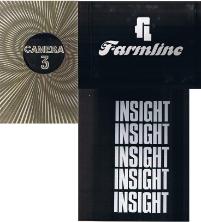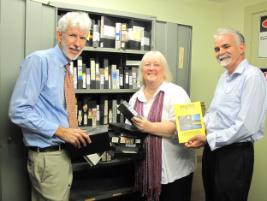Unique window on Rocky found among dusty old videos
Published on 31 March, 2011
Premier Joh visiting flood victims in a tinnie, rock star Peter Garrett in the days when crowds cheered for him, pop sensations the Village People touring rural Queensland, fantastic fashions and salt-of-the-earth locals developing their region...
These are just some of the gems found by fossicking CQUniversity researcher Christina Hunt, who has been dusting off the old videotape archives of programs shot by ABC when it had its own TV station in Rockhampton between 1963-1985.
It's been a labour of love for Christina, who once worked as an archivist for ABC in Sydney. She's been juggling the task with completion of her PhD research into some of the national broadcaster's pioneering TV documentary makers, who worked on programs including A Big Country and Chequerboard.
Assisted by current and former ABC employees, including CQUniversity Adjunct Professor Ross Quinn (a former ABC Capricornia manager) and current cameraman Mike Tregaskis, Christina's project and insights by media historian Professor Denis Cryle have been showcased in the Queensland Review journal published by University of Queensland.

Program graphics from the days when Rockhampton produced its own TV shows
The journal article concludes that the painstaking job of transferring video formats, viewing, shot-listing and cataloguing the hundreds of old ABC videotapes will provide a unique window on Rockhampton and its region's post-war history, people and culture.
In fact, Christina has continued her task beyond the era of ABC Rockhampton's TV station and is now working on tapes from the mid 1990s, as she recognises the value of her work.
"I'm part way through getting the video catalogue on a searchable database which can be useful for ABC's national video database, as there's many little gems only stored in Rockhampton," Christina said.
"TV changed to colour in capital cities in 1975 and Rockhampton went colour only a little later in 1979, meaning there's a lot of colour footage of Rockhampton and region as it grew and changed and developed.
"Some gems include the birth of the Central Highlands coal industry, the bombing and controversy surrounding Yeppoon's Iwasaki resort, criminals coming and going from the courthouse, barbecues on the Post Office verandah to celebrate the opening of Rockhampton's East Street Mall, and protests against sandmining."
Christina says one of the saddest sections of footage is the 1983 coverage of an aircraft crash and a subsequent motorcycle accident which together killed five ABC employees (out of a staff of around 23) within the space of a few months.
The remaining staff managed to solider on under what must have been terrible circumstances. But it was not the loss of personnel which finally closed the TV station in 1985.
Despite much controversy, policy changes, the availability of better communication links and the launch of a new current affairs program (The National) all contributed to ABC's preference for networked programs from metropolitan stations.
Christina says despite the local news coverage by WIN TV and more recently Channel 7, Rockhampton lost a great resource with the closure of its ABC TV Station.
As well as news, the station had produced shows on current affairs (with a pioneering female Aboriginal presenter called Robina Colby), gardening, social updates and rural issues. Older locals may remember program names including Insight, Farmline and Camera3.
"The ABC staff had a wonderful proximity to their subjects due to operating in a small city. This was sometimes problematic if someone wanted to complain but overall the effect was positive in terms of their understanding of the region."
The Queensland Review journal article reveals some fascinating facts about the introduction of TV to regional Australia, in the days before microwave links.
"All ABC TV output emanated from the Rockhampton studios. Network program tapes had to be flown in on a daily basis and the ABC put an elaborate system in place whereby network shows such as the BBC crime series Z Cars went to air in Rockhampton, in Townsville and in Brisbane on separate nights. This arrangement posed serious logistical challenges, particularly in the event of tapes being delayed," the journal article says.
"Before the advent of networked programming feeds from the south, both local and networked programs were introduced by Rockhampton announcers."
The journal article notes that, in addition to around 400 tapes found at ABC's Rockhampton Office, an additional 81 news tapes were found in CQUniversity's local library collection. Subsequently, a collection of 16mm film items was also identified in the ABC's Brisbane archives as belonging to Rockhampton ABC (these 16mm film stories will eventually be incorporated into the project's research outcomes).
Former staff of ABC have contributed memories and photos to add behind-the-scenes background to the stories told by the tapes themselves, adding a valuable human dimension to the project.


